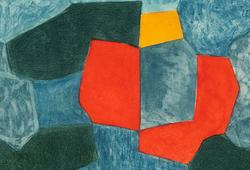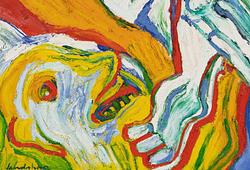A semi-antique Benlian Tabriz carpet of 'Coronation' design, signed Jabarzade, c. 488 x 367 cm.
Around 1930. With a design after the coronation carpet of Edward VII of the United Kingdom, that can be found in the collections of the Los Angeles County Museum of Art (LACMA).
Alkuperä - Provenienssi
Jämför Sotheby's New York, 'Carpets'. 6 June, 2007, lot number 269.
Kirjallisuus
Compare Pal, Pratapaditya, Thomas W. Lentz, Sheila R. Canby, Edwin Binney, 3rd, Walter B. Denny, and Stephen Markel. "Arts from Islamic Cultures: Los Angeles County Museum of Art." Arts of Asia 17, no. 6 (November/December 1987): 73-130.
Muut tiedot
Benlian's star signature reads sherkat-e jabbarzadeh-ye qali-bafiyan va Mahmud, which translates to "Jabbarzadeh's carpet weaving company and Mahmud." While other workshops from the early 20th century, such as PETAG, began producing Tabriz carpets of a similar style, Benlian carpets can be identified by their eight-pointed star marks woven into the corner of each inner secondary border. The Benlian workshop was established in the first half of the 20th century by Edward E. Benlian, a London-based carpet dealer. They wove carpets specifically for the European market. The present carpet is believed to have been commissioned after Edward VII’s coronation in 1902, where a carpet with an identical desig was placed before the king's throne in Westminster Abbey. The carpet also prominently featured in Edwin Austin Abbey's painting of the coronation and was selected for the coronation ceremonies by the Duveen brothers, art dealers commissioned to provide tapestries and carpets. Shortly after the coronation, the carpet was acquired by the American collector Marsden J. Perry. It later belonged to two other notable American tycoon: Clarence Mackay, followed by J. Paul Getty, who donated it to LACMA in 1949.













































